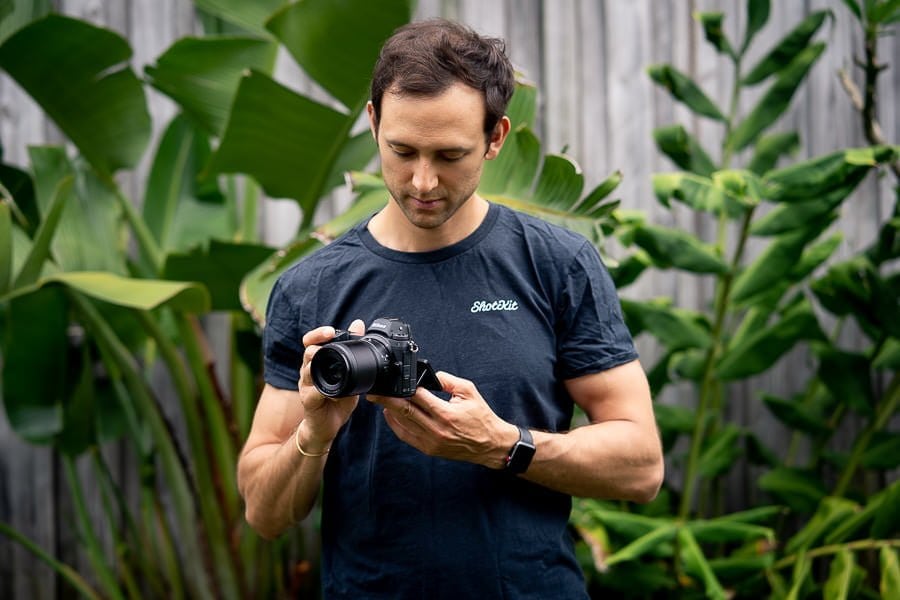Portrait Photographers

I love a good tilt-screen! Checking out the build of the Nikon Z6 in my back garden.
I'm a full-time wedding photographer originally from the UK, currently residing in a small town near Byron Bay in Australia. I've been shooting weddings professionally for close to 10 years, having traveled all over the world doing what I love.
Occasionally I'll get paid to photograph families, events and even real estate, but weddings are my bread and butter.
I'm also the founder of Shotkit, having created it back in 2014 to peek inside the bags of my favourite photographers.
When I'm not reviewing the latest camera bag or testing out editing software, you can find me on some form of leg-powered two-wheeler, be it my gravel, road or mountain bike.
... although I am thinking about getting an e-mtb too :)
Website | Instagram | LinkedIn
My Latest Articles:
If you’re interested in portrait photography, you’re probably wondering which camera, lenses and other gear to invest in.
Instead of a conventional list of essentials, we’ll give you a unique way to learn about portrait photography equipment. Here’s a peek inside the camera bags of dozens of professional portrait photographers.
Many of them give a detailed breakdown of why they chose that equipment, how they use it, and how it helps them to achieve the effects they’re after.
Now, one thing to note about portrait photography is that it’s often paired up with other genres. While there are people out there who make a living purely off shooting portraits, many photographers take portraits in addition to or as part of other work.
For example, you’ll find plenty of photographers whose work spans weddings and events as well as portraits.
Some travel photographers and street photographers take portraits of people they encounter during their wanderings.
Portraits can even feature non-human subjects like wild animals or pets.
Because of this, it’s rare to see a kit that’s built to cater only to portraiture.
One of the defining features of portrait photography is that it’s generally a considered and controlled process. It’s not a fast-paced photographic pursuit where you have to think on your feet and hit the shutter on fleeting moments before they pass.
That means there’s usually more time to adjust settings, fix lighting conditions and change lenses.
Still – you don’t want to keep your subjects standing around for hours. You’re photographing a portrait, not painting it… And some subjects can be more flighty and fidgety than others, which adds to the pressure (kids, for example!).
For this reason, camera systems with eye detection are increasingly valued by portrait photographers and are fast becoming the standard.
If you’re shooting portraits in a studio, you’ll likely want to add a solid tripod to your kit, as well as artificial light sources, reflectors and modifiers. Seeing what other photographers use is helpful here to get a better idea of what you’ll need.
Plenty of portraits are taken outside in natural light. If you want to stick to this route, one of the keys is understanding how the light changes at different times of day and how to adjust your settings to make the most of it.
Shooting in full midday sun, for example, can create harsh shadows on people’s faces. Shooting in golden hour can be perfect for soft, glowy portrait light.
As for lenses, there are particular focal lengths that are considered best for portraits and that show up in portrait photographers’ kits time and time again – such as 35mm, 50mm and 85mm.
The specific lenses themselves will depend on which camera brand and system you’re using, but generally speaking, high quality lenses with wide apertures will give you the best scope for beautiful portraits with nice bokeh and background separation.
The camera systems used by our featured portrait photographers span the gamut from Canon and Nikon DSLR systems to Sony and Fujifilm mirrorless systems, all the way through to vintage film and even wet plate collodion imaging!
You’ll learn a lot from peeking into their camera bags. Developing your own style comes with time; but getting gear you can trust and that suits your needs is definitely a great place to start.





